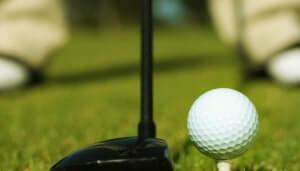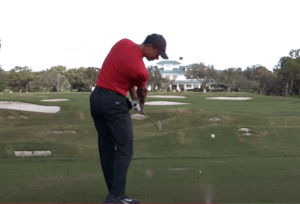Introduction
When it comes to golf, the grip is one of the most fundamental aspects of the game. It is the foundation upon which every swing is built, and can greatly impact the outcome of your shots. But what exactly is the difference between a strong and a weak golf grip? And how can it affect your performance on the course?
A strong golf grip refers to a grip where the hands are rotated more to the right (for a right-handed golfer) on the club. This means that the V formed by the thumb and index finger of the left hand points more towards the right shoulder. On the other hand, a weak golf grip involves rotating the hands more to the left, causing the V to point more towards the left shoulder.
The choice between a strong and weak golf grip is a matter of personal preference and can depend on various factors such as swing style, hand size, and flexibility. Each grip has its own advantages and disadvantages, and finding the right one for you can greatly improve your game.
A strong golf grip can help promote a draw shot, where the ball starts to the right of the target and curves back towards it. This grip can also help you generate more power and distance, as it allows for a stronger release of the clubhead through impact. However, a strong grip may also make it more difficult to hit a straight shot or a fade.
On the other hand, a weak golf grip can be beneficial for players who struggle with slicing the ball. It can help promote a fade or even a straight shot, as it encourages the clubface to remain more square through impact. However, a weak grip may result in a loss of power and distance compared to a strong grip.
In conclusion, understanding the difference between a strong and weak golf grip is essential for any golfer looking to improve their game. By experimenting with both grips and finding the one that suits your swing style and goals, you can unlock your full potential on the course. Stay tuned for our upcoming articles, where we will delve deeper into the intricacies of each grip and provide tips for mastering them.
What is a strong golf grip?
A strong golf grip is a fundamental aspect of a golfer’s swing. It refers to the positioning of the hands on the club and can greatly influence the direction and trajectory of the ball. Understanding the difference between a strong and weak grip is crucial for golfers of all skill levels.
In a strong grip, the hands are rotated more towards the trail side of the club. This means that the V formed by the thumb and index finger of the lead hand (left hand for right-handed golfers) points towards the trail shoulder. The trail hand (right hand for right-handed golfers) also has a stronger grip, with the V pointing towards the lead shoulder. This grip promotes a closed clubface at impact, which can result in a draw or hook shot.
On the other hand, a weak grip involves rotating the hands more towards the lead side of the club. The V formed by the thumb and index finger of the lead hand points more towards the center of the body, while the trail hand has a weaker grip with the V pointing towards the center as well. This grip promotes an open clubface at impact, which can lead to a fade or slice.
The choice between a strong and weak grip ultimately depends on a golfer’s desired shot shape and swing characteristics. Some players naturally prefer a strong grip, while others may find a weak grip more comfortable. It’s important to experiment with different grips and find the one that works best for your game.
In conclusion, understanding the concept of a strong golf grip is essential for any golfer looking to improve their game. By mastering the proper hand positioning, you can gain greater control over your shots and achieve more consistent results on the course. So, whether you prefer a strong or weak grip, take the time to practice and find the grip that suits your swing style and helps you achieve your desired shot shape.
What is a weak golf grip? What are the advantages of a strong grip?
A weak golf grip refers to a grip where the hands are positioned more towards the target side of the club. This means that the left hand (for right-handed golfers) is rotated more to the left, and the right hand is rotated more to the right. On the other hand, a strong golf grip is the opposite, with the hands positioned more towards the rear end of the club.
There are several advantages to having a strong golf grip. Firstly, it promotes a closed clubface at impact, which can help reduce the chances of slicing the ball. This is because the strong grip encourages the hands to rotate more through the impact zone, resulting in a square clubface and straighter shots.
Secondly, a strong grip can increase the golfer’s ability to hit powerful shots. By positioning the hands more towards the rear end of the club, it allows for a stronger wrist hinge during the backswing. This increased wrist hinge creates more lag in the downswing, resulting in greater clubhead speed and increased distance.
Lastly, a strong grip can also improve a golfer’s ability to control the ball flight. With a strong grip, it becomes easier to shape shots, such as drawing or fading the ball. This is because the stronger grip encourages the hands to rotate more, allowing for greater control over the clubface angle.
In conclusion, a weak golf grip positions the hands more towards the target side of the club, while a strong grip positions the hands more towards the rear end. The advantages of a strong grip include reducing the chances of slicing, increasing power and distance, as well as improving control over the ball flight. So, if you’re looking to improve your game, consider experimenting with a stronger grip to see if it works for you.
What are the advantages of a weak grip? What are the disadvantages of a strong grip?
A strong vs weak golf grip is a topic that sparks considerable debate among golfers. While some prefer a strong grip, others opt for a weak grip. Each grip has its advantages and disadvantages, and understanding them can greatly impact your game.
One of the advantages of a weak grip is increased clubface control. With a weak grip, the clubface tends to stay more square to the target throughout the swing, resulting in straighter shots. This grip also promotes a natural release of the clubhead, allowing for better accuracy and consistency.
Additionally, a weak grip can help golfers with a tendency to hook the ball. By reducing the hand action, a weak grip minimizes the chances of the clubface closing too much at impact, resulting in a straighter ball flight.
On the other hand, a strong grip offers some advantages as well. One of the main benefits is increased power. With a strong grip, the hands are positioned more to the right on the club, which can generate more clubhead speed and distance. This grip is often favored by golfers with a slice as it helps to square the clubface at impact, reducing the sidespin.
However, a strong grip can also lead to a lack of control. The closed clubface position may result in a tendency to push the ball to the right or even hook it. It requires precise timing and a consistent swing path to avoid these issues.
In conclusion, both a weak and strong grip have their pros and cons. It ultimately depends on your individual swing style and desired ball flight. Experimenting with different grips and seeking professional advice can help you find the grip that best suits your game and maximizes your performance on the golf course.
What are the disadvantages of a weak grip? How to achieve a strong grip?
A strong grip is essential in golf as it helps improve control and power in your swing. On the other hand, a weak grip can lead to various disadvantages that can hinder your performance on the course.
One of the main disadvantages of a weak grip is a lack of stability. When you have a weak grip, it becomes difficult to maintain a consistent clubface position throughout your swing. This inconsistency can result in mishits and poor ball contact, leading to inaccurate shots and reduced distance.
Another disadvantage of a weak grip is a loss of power. A strong grip allows you to generate more clubhead speed, which translates into greater distance. With a weak grip, you may struggle to generate the necessary power, resulting in shorter shots and difficulty reaching longer holes.
Additionally, a weak grip can contribute to a slice or a fade. When your grip is weak, it promotes an open clubface at impact, causing the ball to spin from left to right for right-handed golfers. This can lead to shots that miss the fairway and end up in trouble.
To achieve a strong grip, start by placing the club in your left hand (for right-handed golfers) with the clubface square to the target. Then, interlock or overlap your right hand onto the club, ensuring that your hands work together as a unit. The V formed by your thumb and index finger on both hands should point towards your right shoulder.
Practicing with a strong grip will help you develop a more stable and powerful swing. It may feel uncomfortable at first, but with time and repetition, it will become natural. Remember to maintain a relaxed grip pressure to avoid tension in your hands and arms.
In conclusion, a weak grip can lead to instability, a loss of power, and a tendency to slice the ball. By working on achieving a strong grip, you can improve your control, power, and overall performance on the golf course.
How to achieve a weak grip?
Having a proper grip is crucial in golf, and understanding the difference between a strong and weak grip can greatly impact your game. While a strong grip provides more control and power, a weak grip allows for greater flexibility and shot shaping. In this article, we will discuss how to achieve a weak grip and improve your golf game.
To achieve a weak grip, start by positioning your lead hand (left hand for right-handed golfers) in a more neutral position. Instead of placing the thumb on top of the grip, position it slightly to the right. This will help weaken your grip and promote a more neutral clubface at impact.
Next, focus on your trail hand (right hand for right-handed golfers). Instead of wrapping your hand around the grip, place it more diagonally across the grip. This will reduce the amount of pressure applied with your trail hand, resulting in a weaker grip.
It’s important to note that achieving a weak grip may feel uncomfortable at first, but with practice, it will become more natural. Spend time on the driving range experimenting with different grip strengths and find what works best for you.
A weak grip can provide several advantages on the golf course. It allows for greater wrist mobility, which is essential for shaping shots and hitting fades or draws. Additionally, a weak grip can help alleviate tension in your hands and arms, promoting a smoother and more fluid swing.
In conclusion, achieving a weak grip in golf requires making adjustments to the positioning of both your lead and trail hands. By practicing and experimenting with different grip strengths, you can find the right balance that works for you. So, the next time you hit the links, give a weak grip a try and see how it improves your game.
In conclusion, the topic of “strong vs weak golf grip” is an important aspect of the game that can greatly impact a golfer’s performance. Throughout this post, we have explored the key points related to this topic, including what constitutes a strong grip and what constitutes a weak grip.
A strong golf grip refers to a grip where the hands are rotated more towards the target, resulting in the V’s formed by the thumbs and index fingers pointing towards the right shoulder for a right-handed golfer. On the other hand, a weak grip involves the hands being rotated more towards the left, with the V’s pointing towards the left shoulder.
Both grips have their advantages and disadvantages. A strong grip can promote a draw shot and provide more power, while a weak grip can help with a fade and provide more control. However, a strong grip may lead to a closed clubface at impact and a tendency to hook the ball, while a weak grip may result in an open clubface and a tendency to slice.
Achieving a strong grip requires proper hand placement and rotation, while achieving a weak grip involves adjusting the hand position accordingly. It is crucial for golfers to experiment with different grips and find the one that suits their swing and desired shot shape.
Looking ahead, it is important to stay updated on any new developments or trends in the world of golf grips. Technology and research may continue to provide insights into the optimal grip for different types of golfers and swings. It is also worth noting that individual preferences and physical attributes play a significant role in determining the ideal grip.
Thank you for taking the time to read this post on “strong vs weak golf grip”. We hope that the information provided has been helpful in understanding the importance of grip in golf. We encourage you to leave any comments or feedback, as well as share your own experiences with different grips. Remember, finding the right grip can greatly enhance your game and lead to improved performance on the course.







